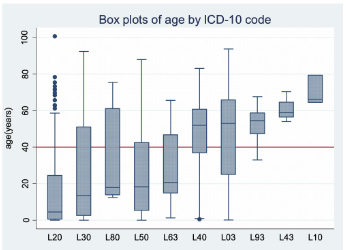Prevalence and Pattern of Diseases of The Skin and Subcutaneous Tissue in A Primary Care Area in Thailand
DOI:
https://doi.org/10.33192/Smj.2021.47Keywords:
Prevalence, skin disease, ThailandAbstract
Objective: Information on the population-based prevalence study of skin diseases is still lacking. The study explores the prevalence and pattern of diagnosed skin diseases of the population in a primary care area of a university hospital in Thailand.
Materials and Methods: Skin disease patients were identified using the International Statistical Classification of Diseases and Related Health Problems 10th Revision codes (L00-L99). Retrospective data were obtained from the hospital electronic medical record between 2015-2019. The number of clinic visits and the number of skin disease diagnoses were counted. The five-year period prevalence was calculated by dividing the number of cases by the population in the primary care area.
Results: During the five-year period, in a population of 29,969, we found 3,770 patients (12.6% of 29,969 population) who made 7,433 outpatient visits with the diagnoses of skin diseases. Infections of the skin and subcutaneous tissues were the most common (37.3%), followed by dermatitis (29.7%), urticaria and erythema (13.9%), other disorders of the skin and subcutaneous tissue (8.6%), and papulosquamous disorders (1.7%). The five-year period prevalence of skin diseases per 100,000 persons was as following: cellulitis (2,296), urticaria (1,682), psoriasis (177), atopic dermatitis (420), seborrheic dermatitis (227), alopecia areata (50), vitiligo (23), and pemphigus (10).
Conclusion: Infection and dermatitis were the two most common skin diseases in the primary care area population. Atopic dermatitis, psoriasis, seborrheic dermatitis, and decubitus ulcer were less commonly found. Our prevalence data should be the “at least” prevalence of skin diseases due to possible underreporting.
References
2. Karimkhani C, Dellavalle RP, Coffeng LE, Flohr C, Hay RJ, Langan SM, et al. Global Skin Disease Morbidity and Mortality: An Update From the Global Burden of Disease Study 2013. JAMA Dermatol 2017;153:406-12.
3. Sumriddetchkajorn K, Shimazaki K, Ono T, Kusaba T, Sato K, Kobayashi N. Universal health coverage and primary care, Thailand. Bull World Health Organ 2019;97:415-22.
4. Baghestani S, Zare S, Mahboobi AA. Skin disease patterns in Hormozgan, Iran. Int J Dermatol 2005;44:641-5.
5. Soria Orozco M, Padron Salas A, Shiguetomi Sifuentes AL, Amezcua Gudiño S, Ramirez Padilla M, Huerta Rivera G, et al. Prevalence of skin diseases among hospitals in the public healthcare system of a developing country. Int J Dermatol 2019;58:563-8.
6. Wisuthsarewong W, Viravan S. Analysis of skin diseases in a referral pediatric dermatology clinic in Thailand. J Med Assoc Thai 2000;83:999-1004.
7. Jiamton S, Leeyaphan S, Prasertworonun N, Omcharoen W. Skin Diseases among Elderly Attending Out-patient Dermatologic Clinic, Siriraj Hospital. Siriraj Med J 2014;66:219-24.
8. Svensson A, Ofenloch RF, Bruze M, Naldi L, Cazzaniga S, Elsner P, et al. Prevalence of skin disease in a population-based sample of adults from five European countries. Br J Dermatol 2018;178:1111-8.
9. Wessman LL, Andersen LK, Davis MDP. Incidence of diseases primarily affecting the skin by age group: population-based epidemiologic study in Olmsted County, Minnesota, and comparison with age-specific incidence rates worldwide. Int J Dermatol 2018;57:1021-34.
10. Rea JN, Newhouse ML, Halil T. Skin disease in Lambeth. A community study of prevalence and use of medical care. Br J Prev & Social Med 1976;30:107-14.
11. Ellis Simonsen SM, van Orman ER, Hatch BE, Jones SS, Gren LH, Hegmann KT, et al. Cellulitis incidence in a defined population. Epidemiol Infect 2006;134:293-9.
12. Kim YS, Park SH, Han K, Bang CH, Lee JH, Park YM. Prevalence and incidence of chronic spontaneous urticaria in the entire Korean adult population. Br J Dermatol 2018;178:976-7.
13. Chu CY, Cho YT, Jiang JH, Lin EI, Tang CH. Epidemiology and comorbidities of patients with chronic urticaria in Taiwan: A nationwide population-based study. J Dermatol Sci 2017;88:192-8.
14. Tsai TF, Rajagopalan M, Chu CY, Encarnacion L, Gerber RA, Santos-Estrella P, et al. Burden of atopic dermatitis in Asia. J Dermatol 2019;46:825-34.
15. Bas Y, Seckin HY, Kalkan G, Takci Z, Citil R, Onder Y, et al. Prevalence and related factors of psoriasis and seborrheic dermatitis: a community-based study. Turkish J Med Sci 2016;46:303-9.
16. Global psoriasis atlas. Prevalence data [homepage on Internet]. St Louise: International Psoriais Council; 2019 [cited 2020 August 6]. Available from:https://globalpsoriasisatlas.org/statistics/prevalence.
17. Soh BW, Kim SM, Kim YC, Choi GS, Choi JW. Increasing prevalence of alopecia areata in South Korea. J Dermatol 2019;46:e331-e2.
18. Kruger C, Schallreuter KU. A review of the worldwide prevalence of vitiligo in children/adolescents and adults. Int J Dermatol 2012;51:1206-12.
19. Wertenteil S, Garg A, Strunk A, Alloo A. Prevalence Estimates for Pemphigus in the United States: A Sex- and Age-Adjusted Population Analysis. JAMA Dermatol 2019;155:627-9.

Published
How to Cite
Issue
Section
License

This work is licensed under a Creative Commons Attribution-NonCommercial-NoDerivatives 4.0 International License.
Authors who publish with this journal agree to the following conditions:
Copyright Transfer
In submitting a manuscript, the authors acknowledge that the work will become the copyrighted property of Siriraj Medical Journal upon publication.
License
Articles are licensed under a Creative Commons Attribution-NonCommercial-NoDerivatives 4.0 International License (CC BY-NC-ND 4.0). This license allows for the sharing of the work for non-commercial purposes with proper attribution to the authors and the journal. However, it does not permit modifications or the creation of derivative works.
Sharing and Access
Authors are encouraged to share their article on their personal or institutional websites and through other non-commercial platforms. Doing so can increase readership and citations.














